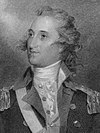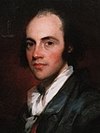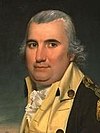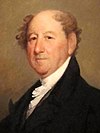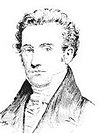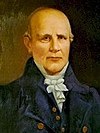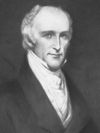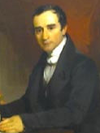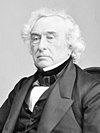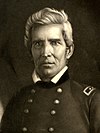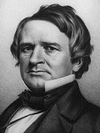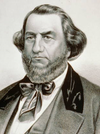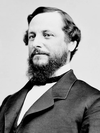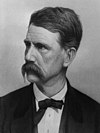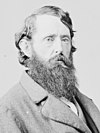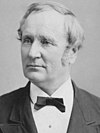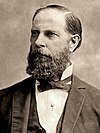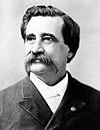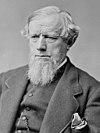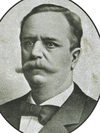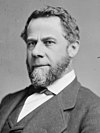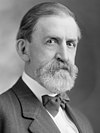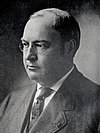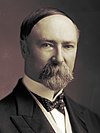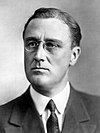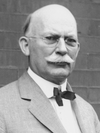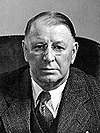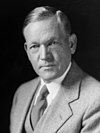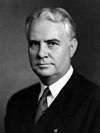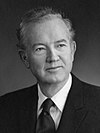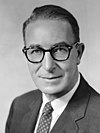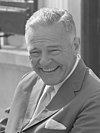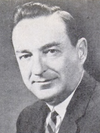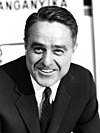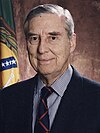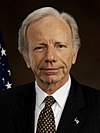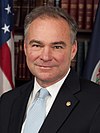List_of_unsuccessful_major_party_candidates_for_Vice_President_of_the_United_States
List of unsuccessful major party candidates for Vice President of the United States
Add article description
The United States has had a two-party system for much of its history, and the two major parties have nominated vice presidential candidates in most presidential elections.[1] Since the ratification of the United States Constitution in 1789, there have been 59 unsuccessful major party candidates for Vice President of the United States. Eight other individuals have served as the main running mate to a third party or independent presidential candidate who won at least ten percent of the popular or electoral vote.
Prior to the ratification of the Twelfth Amendment in 1804, each member of the Electoral College cast two votes for president; whichever individual who won the most electoral votes would become president, while the individual with the second-most electoral votes would become vice president. In the elections of 1792, 1796, and 1800, at least one of the major parties ran a candidate whom they intended to elect vice president. The Twelfth Amendment changed the presidential election process, requiring members of the Electoral College to cast separate votes for president and vice president. Since then, the two major parties have almost always nominated a ticket consisting of a single presidential candidate and a single vice presidential candidate. Before the election of 1832, both major parties used a congressional nominating caucus, or nominations by state legislatures, to determine presidential and vice presidential candidates.[2] Since 1840, each major party has consistently nominated a single ticket at their respective presidential nominating conventions.
The two current major parties are the Democratic Party and the Republican Party. At various points prior to the American Civil War, the Federalist Party, the Democratic-Republican Party, the National Republican Party, and the Whig Party were major parties.[1] In the 1872 presidential election, the Liberal Republican Party put forward an unsuccessful major party vice presidential nominee, Benjamin Gratz Brown. Brown and his running mate, Horace Greeley, were also nominated by the Democratic Party.[3]
These unsuccessful vice presidential candidates served as the main running mate of a major party presidential candidate who competed in multiple states, or they were a major party's main vice presidential candidate in multiple states.
- * indicates that the candidate served as vice president at some point in their career
These third party and independent candidates won at least ten percent of the electoral vote for vice president, or served as the main running mate to a third party or independent presidential candidate who won at least ten percent of the popular vote for president.[81]
- In the 1792 election, George Washington effectively ran unopposed for president, but the emerging Democratic-Republican Party attempted to defeat Vice President John Adams's bid for re-election.[6] Adams won re-election with 77 electoral votes, while Clinton won 50 electoral votes Thomas Jefferson, won four electoral votes, and Aaron Burr won one electoral vote.
- The Democratic-Republicans may or may not have officially nominated Thomas Jefferson for president through a congressional nominating caucus, but Jefferson was widely regarded as the party's main presidential candidate in the 1796 election. The Democratic-Republicans did not select an official vice presidential candidate. Aaron Burr finished with the second-most electoral votes among individuals affiliated with the party, while Samuel Adams and George Clinton each received several electoral votes. Federalist leaders agreed to support a ticket of John Adams and Thomas Pinckney, though it is unclear whether they formally nominated the ticket at a congressional nominating caucus.[8] Ultimately, Adams won the most electoral votes and became president. Because Jefferson won more electoral votes than Pinckney or Burr, he was elected as vice president.[4]
- Both parties held congressional nominating caucuses to nominate presidential candidates in 1800. The Democratic-Republicans nominated Thomas Jefferson and Aaron Burr, while the Federalists nominated John Adams and Charles Cotesworth Pinckney. Some Federalist leaders, including Alexander Hamilton, favored Pinckney over Adams, but Adams won one more electoral vote than Pinckney.[11] Jefferson and Burr each won the votes of 73 presidential electors, more than either of the Federalist candidates. Because Jefferson and Burr tied in the electoral vote, the election was decided by a contingent election held in the House of Representatives; Jefferson was elected president and Burr became vice president.[4]
- Ingersoll had also served as a delegate to the Continental Congress and to the Constitutional Convention.[14]
- The Federalists did not nominate a ticket in 1816, though some Federalists were elected to serve as presidential electors. A majority of the Federalist electors cast their presidential vote for Rufus King and their vice presidential vote for Howard.[15]
- In the election 1824, no presidential candidate won a majority of the electoral vote for president, but John C. Calhoun won a majority of the electoral vote for vice president. Most presidential electors who voted for either John Quincy Adams or Andrew Jackson for president voted for Calhoun for vice president. Similarly, most electors who cast their presidential vote for Henry Clay cast their vice presidential vote for Nathaniel Macon, and most electors who cast their presidential vote for William H. Crawford cast their vice presidential vote for Sanford.[4]
- Sanford was the Chancellor of New York, the highest-ranking judge in the state. He had also served in the United States Senate.[17]
- The Whigs did not select an official presidential or vice presidential nominee in 1836. In most Northern states, the Whigs fielded a ticket of William Henry Harrison and Francis Granger, and in most Southern states, the Whigs fielded a ticket of Hugh Lawson White and John Tyler.[21] Granger, Tyler, and two Democrats, Richard Mentor Johnson and William Smith, each won a share of the electoral vote.[4] Because no one candidate won a majority of the electoral vote for vice president, the Senate held a contingent election to select the vice president. In the only contingent election that the Senate has ever held, Johnson defeated Granger.[22]
- The 1840 Democratic National Convention denied renomination to Vice President Richard Mentor Johnson, and the Democrats failed to officially nominate a vice presidential candidate in 1840.[25] Nonetheless, 48 of the 60 presidential electors who cast their presidential vote for Van Buren cast their vice presidential vote for Johnson. Most of the remaining Van Buren electors cast their vice presidential vote for Littleton Waller Tazewell.[26]
- Butler had also served as a major general of volunteers in the Mexican–American War.[29]
- After the collapse of the Whig Party in the mid-1850s, the Republican Party and the American Party (the political organization of the Know Nothing movement) emerged as the major challengers to the Democratic Party. By 1856, neither the Republican nor the American Party had truly supplanted the Whig Party as the second major political party in the United States.[31] Nonetheless, the American Party is frequently described as a third party.[32][33][34] After the 1856 election, the Republican Party firmly established itself as one of the two major parties alongside the Democratic Party, while the American Party collapsed.[35]
- The Democratic Party fractured along sectional lines in 1860 and held multiple national conventions. The Northern Democrats nominated Douglas and the Southern Democrats nominated Vice President John C. Breckinridge.[37][38] Many sources include Breckinridge as a third party candidate,[39][4][40] but other sources do not.[41][5]
- Horace Greeley and Benjamin Gratz Brown were nominated by the Liberal Republican Party, a splinter group of Republicans. The ticket of Greeley and Brown was later nominated by the 1872 Democratic National Convention, as the Democrats hoped to defeat President Ulysses S. Grant's re-election bid by uniting with the Liberal Republicans.[3][46]
- In 1896, after William Jennings Bryan won the Democratic presidential nomination, he was also nominated by the Populist Party, a major third party. The Populist vice presidential nominee was Thomas E. Watson.[52] Bryan's running mate on the Democratic ticket, Arthur Sewall, won 149 electoral votes for vice president, while Watson won 27 electoral votes for vice president.[4]
- Sewall was a member of the Democratic National Committee from 1888 to 1896.
- Kern was the Democratic nominee for Governor of Indiana in the 1900 and 1904 elections.[55]
- Sherman died on October 30, 1912, and Taft did not name another running mate before the 1912 election was held. After the election, the Republican National Committee designated Nicholas Murray Butler as Taft's running mate for the purposes of the electoral vote, and Butler received eight electoral votes.[56]
- Knox was primarily known as the editor of the Chicago Daily News.
- Miller also served as Chairman of the Republican National Committee from 1961 to 1964.[67]
- The 1972 Democratic National Convention selected Thomas Eagleton as the party's vice presidential nominee, but Eagleton dropped out of the race after it was publicly disclosed that he had undergone electroconvulsive therapy in order to treat depression. Shriver replaced Eagleton on the Democratic ticket.[69]
- Blake, Aaron (April 27, 2016). "Why are there only two parties in American politics?". Washington Post. Retrieved September 18, 2018.
- Morgan (1969), p. 195
- Hale (1950), p. 338
- "United States Presidential Election Results". Dave Leip's Atlas of U.S. Presidential Elections. Retrieved September 16, 2018.
- "Electoral College Box Scores 1789-1996". National Archives and Records Administration. Retrieved September 16, 2018.
- Thompson (1980), pp. 174–175
- "CLINTON, George, (1739 - 1812)". Biographical Directory of the United States Congress. United States Congress. Retrieved September 26, 2018.
- Morgan (1969), pp. 185–186
- "PINCKNEY, Thomas, (1750 - 1828)". Biographical Directory of the United States Congress. United States Congress. Retrieved September 26, 2018.
- "BURR, Aaron, (1756 - 1836)". Biographical Directory of the United States Congress. United States Congress. Retrieved September 26, 2018.
- Morgan (1969), pp. 186–187
- "Charles Cotesworth Pinckney". Biography.com. A&E Television Networks, LLC. Retrieved September 21, 2018.
- "KING, Rufus, (1755 - 1827)". Biographical Directory of the United States Congress. United States Congress. Retrieved September 21, 2018.
- "INGERSOLL, Jared, (1749 - 1822)". Biographical Directory of the United States Congress. United States Congress. Retrieved September 26, 2018.
- Deskins et al. (2010), pp. 65
- "HOWARD, John Eager, (1752 - 1827)". Biographical Directory of the United States Congress. United States Congress. Retrieved September 26, 2018.
- "SANFORD, Nathan, (1777 - 1838)". Biographical Directory of the United States Congress. United States Congress. Retrieved September 26, 2018.
- "MACON, Nathaniel, (1757 - 1837)". Biographical Directory of the United States Congress. United States Congress. Retrieved September 26, 2018.
- "Richard Rush (1825–1829)". Miller Center. University of Virginia. October 4, 2016. Retrieved September 25, 2018.
- "SERGEANT, John, (1779 - 1852)". Biographical Directory of the United States Congress. United States Congress. Retrieved September 26, 2018.
- Peterson (1989), pp. 19–20
- Deskins et al. (2010), pp. 108–109
- "GRANGER, Francis, (1792 - 1868)". Biographical Directory of the United States Congress. United States Congress. Retrieved September 26, 2018.
- "TYLER, John, (1790 - 1862)". Biographical Directory of the United States Congress. United States Congress. Retrieved September 26, 2018.
- Sirgiovanni (1994), pp. 767–768
- "Richard Mentor Johnson, 9th Vice President (1837-1841)". United States Senate. Retrieved September 22, 2018.
- "JOHNSON, Richard Mentor, (1780 - 1850)". Biographical Directory of the United States Congress. United States Congress. Retrieved September 26, 2018.
- "FRELINGHUYSEN, Theodore, (1787 - 1862)". Biographical Directory of the United States Congress. United States Congress. Retrieved September 26, 2018.
- "BUTLER, William Orlando, (1791 - 1880)". Biographical Directory of the United States Congress. United States Congress. Retrieved September 26, 2018.
- "GRAHAM, William Alexander, (1804 - 1875)". Biographical Directory of the United States Congress. United States Congress. Retrieved September 26, 2018.
- McPherson (1988), pp. 140–144, 153–154
- Cooper, William (October 4, 2016). "James Buchanan: Campaigns and Elections". Miller Center. University of Virginia. Retrieved September 19, 2018.
- Boissoneault, Lorraine (January 26, 2017). "How the 19th-Century Know Nothing Party Reshaped American Politics". Smithsonian. Retrieved September 19, 2018.
- Hicks (1933), p. 10
- Gienapp (1985), p. 547
- "DAYTON, William Lewis, (1807 - 1864)". Biographical Directory of the United States Congress. United States Congress. Retrieved September 26, 2018.
- Smith (1975), pp. 106–113
- VandeCreek, Drew E. "Campaign of 1860". Northern Illinois University Libraries. Retrieved September 19, 2018.
- Patch, B. W. (1936). "Third Party Movements in American Politics". CQPress. Retrieved September 19, 2018.
- Rosenstone et al. (2018), pp. 59–63
- Hicks (1933), pp. 3–28
- "JOHNSON, Herschel Vespasian, (1812 - 1880)". Biographical Directory of the United States Congress. United States Congress. Retrieved September 26, 2018.
- "PENDLETON, George Hunt, (1825 - 1889)". Biographical Directory of the United States Congress. United States Congress. Retrieved September 26, 2018.
- "BLAIR, Francis Preston, Jr., (1821 - 1875)". Biographical Directory of the United States Congress. United States Congress. Retrieved September 26, 2018.
- "BROWN, Benjamin Gratz, (1826 - 1885)". Biographical Directory of the United States Congress. United States Congress. Retrieved September 26, 2018.
- Frail, T. A. (July 26, 2018). "The Only Time a Major Party Embraced a Third-Party Candidate for President". Smithsonian. Retrieved September 19, 2018.
- "HENDRICKS, Thomas Andrews, (1819 - 1885)". Biographical Directory of the United States Congress. United States Congress. Retrieved September 26, 2018.
- "ENGLISH, William Hayden, (1822 - 1896)". Biographical Directory of the United States Congress. United States Congress. Retrieved September 26, 2018.
- "LOGAN, John Alexander, (1826 - 1886)". Biographical Directory of the United States Congress. United States Congress. Retrieved September 26, 2018.
- "THURMAN, Allen Granberry, (1813 - 1895)". Biographical Directory of the United States Congress. United States Congress. Retrieved September 26, 2018.
- "Biographies: Reid, Whitelaw". HarpWeek. HarpWeek, LLC. Retrieved September 26, 2018.
- Kazin (2006), pp. 63–65
- "STEVENSON, Adlai Ewing, (1835 - 1914)". Biographical Directory of the United States Congress. United States Congress. Retrieved September 26, 2018.
- "DAVIS, Henry Gassaway, (1823 - 1916)". Biographical Directory of the United States Congress. United States Congress. Retrieved September 26, 2018.
- "KERN, John Worth, (1849 - 1917)". Biographical Directory of the United States Congress. United States Congress. Retrieved September 26, 2018.
- "James S. Sherman, 27th Vice President (1909-1912)". United States Senate. Retrieved September 26, 2018.
- "SHERMAN, James Schoolcraft, (1855 - 1912)". Biographical Directory of the United States Congress. United States Congress. Retrieved September 26, 2018.
- "FAIRBANKS, Charles Warren, (1852 - 1918)". Biographical Directory of the United States Congress. United States Congress. Retrieved September 26, 2018.
- "Governor Charles Wayland Bryan". National Governors Association. Retrieved September 26, 2018.
- "ROBINSON, Joseph Taylor, (1872 - 1937)". Biographical Directory of the United States Congress. United States Congress. Retrieved September 26, 2018.
- "CURTIS, Charles, (1860 - 1936)". Biographical Directory of the United States Congress. United States Congress. Retrieved September 26, 2018.
- "McNARY, Charles Linza, (1874 - 1944)". Biographical Directory of the United States Congress. United States Congress. Retrieved September 26, 2018.
- "BRICKER, John William, (1893 - 1986)". Biographical Directory of the United States Congress. United States Congress. Retrieved September 26, 2018.
- "SPARKMAN, John Jackson, (1899 - 1985)". Biographical Directory of the United States Congress. United States Congress. Retrieved September 26, 2018.
- "KEFAUVER, Carey Estes, (1903 - 1963)". Biographical Directory of the United States Congress. United States Congress. Retrieved September 26, 2018.
- "LODGE, Henry Cabot, Jr., (1902 - 1985)". Biographical Directory of the United States Congress. United States Congress. Retrieved September 26, 2018.
- "MILLER, William Edward, (1914 - 1983)". Biographical Directory of the United States Congress. United States Congress. Retrieved September 26, 2018.
- "MUSKIE, Edmund Sixtus, (1914 - 1996)". Biographical Directory of the United States Congress. United States Congress. Retrieved September 26, 2018.
- Clymer, Adam (March 5, 2007). "Thomas F. Eagleton, 77, a Running Mate for 18 Days, Dies". New York Times. Retrieved September 22, 2018.
- "DOLE, Robert Joseph, (1923 - )". Biographical Directory of the United States Congress. United States Congress. Retrieved September 26, 2018.
- "MONDALE, Walter Frederick, (1928 - )". Biographical Directory of the United States Congress. United States Congress. Retrieved September 21, 2018.
- "FERRARO, Geraldine Anne, (1935 - 2011)". Biographical Directory of the United States Congress. United States Congress. Retrieved September 26, 2018.
- "BENTSEN, Lloyd Millard, Jr., (1921 - 2006)". Biographical Directory of the United States Congress. United States Congress. Retrieved September 26, 2018.
- "QUAYLE, James Danforth (Dan), (1947 - )". Biographical Directory of the United States Congress. United States Congress. Retrieved September 26, 2018.
- "KEMP, Jack French, (1935 - 2009)". Biographical Directory of the United States Congress. United States Congress. Retrieved September 26, 2018.
- "LIEBERMAN, Joseph I., (1942 - )". Biographical Directory of the United States Congress. United States Congress. Retrieved September 26, 2018.
- "EDWARDS, John, (1953 - )". Biographical Directory of the United States Congress. United States Congress. Retrieved September 26, 2018.
- "RYAN, Paul D., (1970 - )". Biographical Directory of the United States Congress. United States Congress. Retrieved September 26, 2018.
- "KAINE, Timothy Michael (Tim), (1958 - )". Biographical Directory of the United States Congress. United States Congress. Retrieved September 26, 2018.
- "PENCE, Mike (1959-)". Biographical Directory of the United States Congress. Retrieved August 20, 2020.
- Rosenstone et al. (2018), Appendix A
- "Adams, Charles Francis, (1807 - 1886)". Biographical Directory of the United States Congress. United States Congress. Retrieved January 21, 2019.
- Southwick (1998), p. 251
- "Lane, Joseph, (1801 - 1881)". Biographical Directory of the United States Congress. United States Congress. Retrieved January 21, 2019.
- "Everett, Edward, (1794 - 1865)". Biographical Directory of the United States Congress. United States Congress. Retrieved January 21, 2019.
- "Johnson, Hiram Warren, (1866 - 1945)". Biographical Directory of the United States Congress. United States Congress. Retrieved January 21, 2019.
- "Wheeler, Burton Kendall, (1882 - 1975)". Biographical Directory of the United States Congress. United States Congress. Retrieved January 21, 2019.
- Southwick (1998), pp. 697–698
- Southwick (1998), pp. 768–769
- Holmes, Steven A. (July 6, 2005). "James Stockdale, Perot's Running Mate in '92, Dies at 81". New York Times.
Works cited
- Deskins, Donald Richard; Walton, Hanes; Puckett, Sherman (2010). Presidential Elections, 1789-2008: County, State, and National Mapping of Election Data. University of Michigan Press. ISBN 978-0472116973.
- Gienapp, William E. (1985). "Nativism and the Creation of a Republican Majority in the North before the Civil War". The Journal of American History. 72 (3): 529–555. doi:10.2307/1904303. JSTOR 1904303. S2CID 159570266.
- Hale, William Harlan (1950). Horace Greeley: Voice of the People. Harper & Brothers. OCLC 336934.
- Hicks, John D. (1933). "The Third Party Tradition in American Politics". The Mississippi Valley Historical Review. 20 (1): 3–28. doi:10.2307/1902325. JSTOR 1902325.
- Kazin, Michael (2006). A Godly Hero: The Life of William Jennings Bryan. Knopf. ISBN 978-0375411359.
- McPherson, James M. (1988). Battle Cry of Freedom: The Civil War Era. Oxford University Press. ISBN 9780199743902.
- Morgan, William G. (1969). "The Origin and Development of the Congressional Nominating Caucus". Proceedings of the American Philosophical Society. 113 (2): 184–196. JSTOR 985965.
- Peterson, Norma Lois (1989). The Presidencies of William Henry Harrison and John Tyler. University Press of Kansas. ISBN 978-0-7006-0400-5.
- Rosenstone, Steven J.; Behr, Roy L.; Lazarus, Edward H. (2018). Third Parties in America: Citizen Response to Major Party Failure (2nd ed.). Princeton University Press. ISBN 9780691190525.
- Sirgiovanni, George S. (1994). "Dumping the Vice President: An Historical Overview and Analysis". Presidential Studies Quarterly. 24 (4): 765–782. JSTOR 27551324.
- Smith, Elbert B. (1975). The Presidency of James Buchanan. University Press of Kansas. ISBN 978-0-7006-0132-5.
- Southwick, Leslie (1998). Presidential Also-Rans and Running Mates, 1788 through 1996 (Second ed.). McFarland. ISBN 0-7864-0310-1.
- Thompson, Harry C. (1980). "The Second Place in Rome: John Adams as Vice President". Presidential Studies Quarterly. 10 (2): 171–178. JSTOR 27547562.

